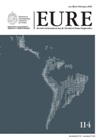Urban Quality Configuration Indexes. The Case of the Federal District, Brazil
DOI:
https://doi.org/10.4067/S0250-71612012000200009Keywords:
spatial distribution, urban sprawl, urban morphologyAbstract
There has been great progress in the search for understanding and analysis of urban systems, especially with the development of indices and indicators that express the characteristics and behavior of fragments of the city. This study seeks to fill the gaps still persisting in that field with a proposal to "stitch" important urban indices, surveyed from large configurational dimension, as a way to compose a new vision of the city. The object of study is the Federal District, Brazil's capital, because of its segmented configuration, is a great experiment, because each segment of the city has intrinsic characteristics. The selected dimensions show in a general way that the urban center of the Federal District, composed of the Pilot Plan and its surroundings, shows better results for all indices surveyed, while worst living conditions are found further away from the center become the. Despite this trend, many peripheral cities, which have the stigma of low status, have good results in certain respects.
ÍDownloads
Published
How to Cite
Issue
Section
License
Copyright (c) 2012 Revista EURE - Revista de Estudios Urbano Regionales

This work is licensed under a Creative Commons Attribution 4.0 International License.
Al momento de aceptar la publicación de sus artículos, los autores deberán formalizar la cesión de derechos de autor a EURE, según las condiciones establecidas por la Revista.
Ésta establece que el autor autoriza a EURE de manera gratuita, exclusiva e ilimitada a reproducir, editar, publicar, distribuir, publicitar, comercializar y traducir el artículo, a cualquier soporte conocido o por conocer y desarrollar.
Del mismo modo, los autores aseguran que el artículo propuesto es original, no publicado y no propuesto para tal fin a otro medio de difusión.


